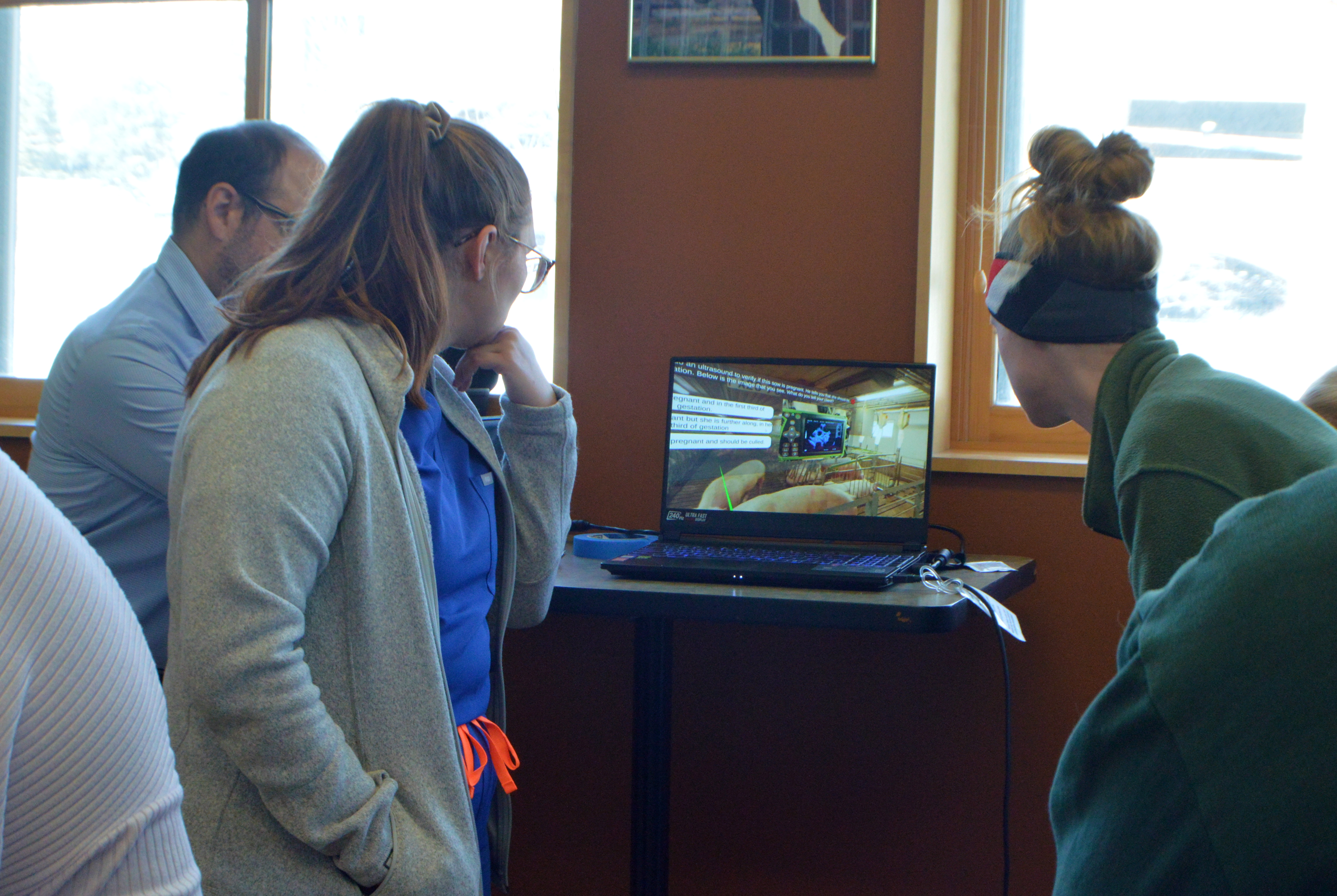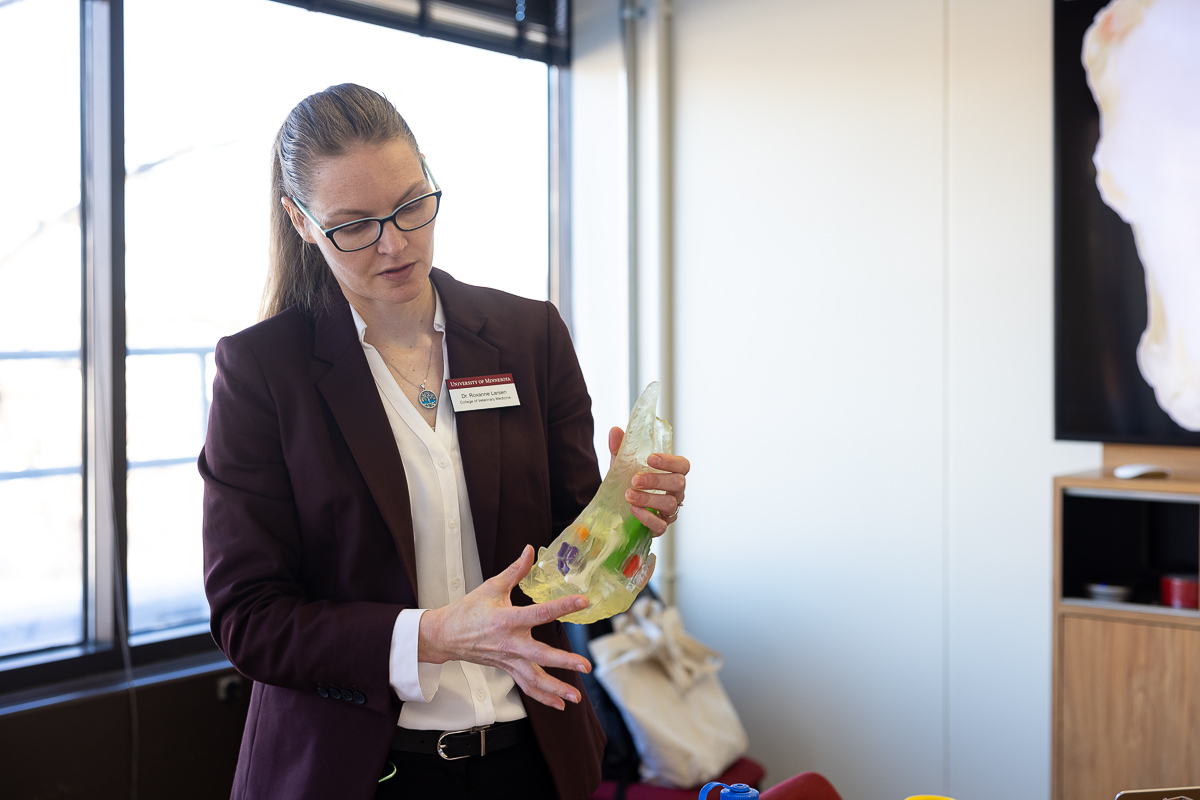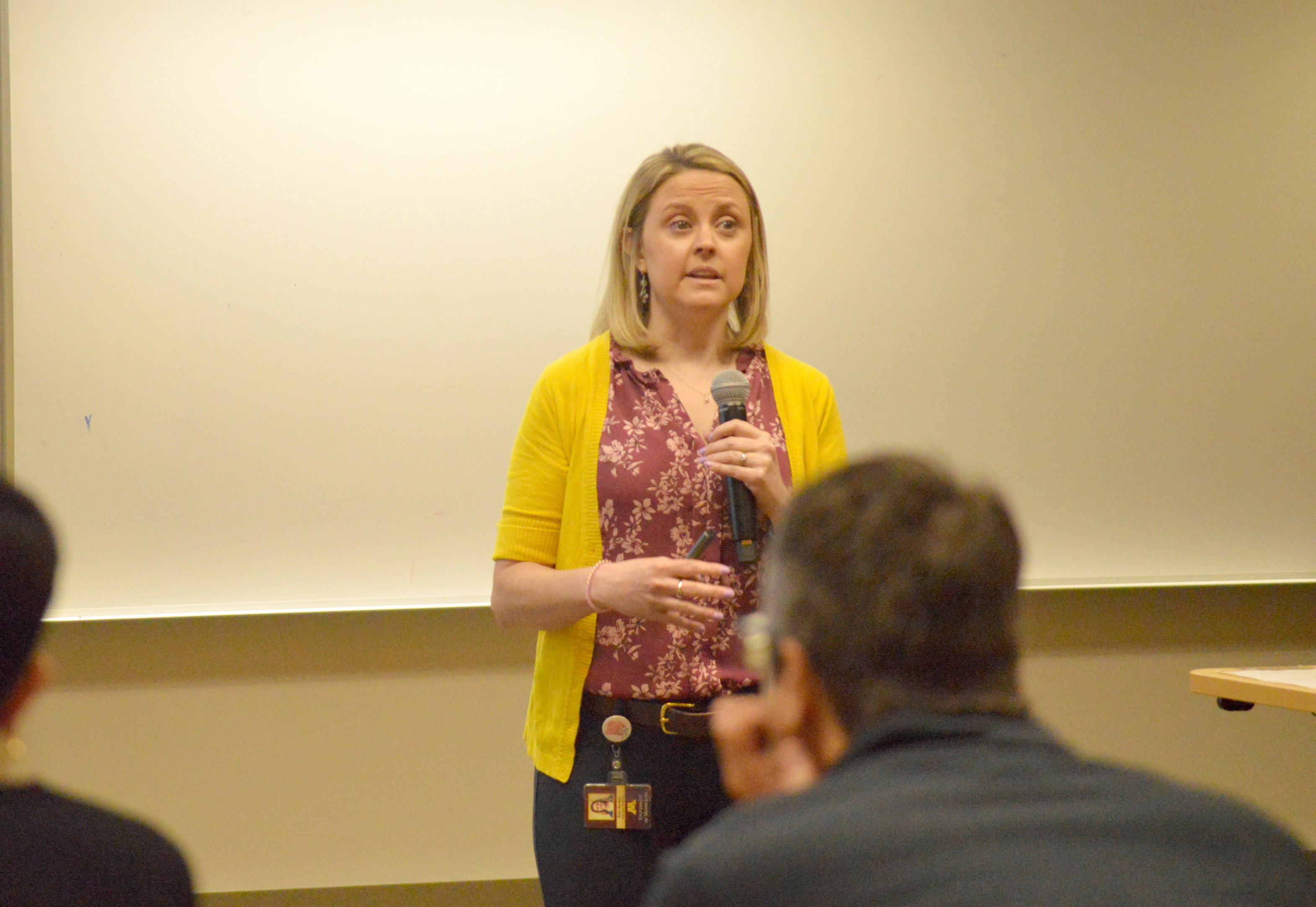Evolving education
History of innovative teaching approaches at CVM elevates current and future student learning experiences

History of innovative teaching approaches at CVM elevates current and future student learning experiences
A class of College of Veterinary Medicine (CVM) DVM students toured a swine farm this spring, but it wasn’t a typical field trip. There was no special gear to be worn or health precautions to take. In fact, the tour group didn’t even have to leave the University of Minnesota St. Paul campus.
About 40 students took the journey through a virtual reality (VR) experience crafted by Dr. Perle Zhitnitskiy with help from a cross-discipline team. With many swine farms located far outside the Twin Cities metro area, a set of three VR headsets made a trip possible for her class to experience in the course of about an hour.
“We know that the best way to inspire DVM students to pursue a career in production animal medicine is to expose them to this type of practice, to the animals, and to the farms early in their student career,” says Zhitnitskiy, an associate professor in the Department of Veterinary Population Medicine (VPM). “The VR experience allowed me to bring the farm to the classroom to increase students' exposure without having to solve the logistical aspects of a field trip for a large group of students.”
Integrating virtual reality into the student experience is just one example of the ever-evolving instruction at CVM. Innovation has long been part of the College’s approach to and expectation for education and continues to advance the student experience. Faculty and staff have honed new approaches, tools, strategies, and more to engage students and prepare them for the careers that await them after graduation.

Proper preparation comes down to more than asking students to memorize facts, figures, and techniques. The veterinary profession is rife with unique situations that require creative problem-solving and critical thinking. Instructors such as Dr. Erin Malone, the assistant dean for curriculum and a professor in the VPM, encourage students to take a multi-faceted approach to problems.
For example, how to properly de-horn a unicorn sounds like a topic of discussion during a tabletop gaming session, but it’s a very real exam question Malone has posed to her large animal surgery students. The students are expected to think critically, drawing on knowledge they’ve gained from the course to inform their approach to providing care to this fantastical beast.

“We learn how to de-horn goats, we learn how to anesthetize goats and horses, and we learn how to de-horn cattle,” Malone says. “They have all these different animal models they need to pull from to decide which model works best for a unicorn—both for the de-horning and for the anesthesia.”
For more reality-based students, she offers a similarly complex query: How would you castrate a kangaroo? This teaching strategy is part of an approach that Malone—and many others across the College—has tweaked over the years as new evidence regarding learning and retention continues to come to light.
One of the largest drivers of innovation in instruction is technology. A seemingly endless array of software, programs, and devices all have the potential to enhance the student learning experience if adopted and wielded successfully by educators.
Prior to the COVID-19 pandemic forcing the world into a new level of digital interaction, Dawn Foster-Hartnett was among those producing online lectures. Foster-Harnett is an associate professor in the Department of Veterinary and Biomedical Sciences and focuses on microbiology and antibiotic resistance.
“When I started teaching, like a lot of people, I didn't have a lot of formal training so I taught as I was taught,” Foster-Hartnett says, “which was you go up and you give this really great lecture, and people listen to it, and then then you give them quizzes and exams. As time went on, I realized how important it was to have interaction with students, to have active learning in the classroom, and collaborative learning.”
In 2019, enrollment in the general microbiology course she teaches was expected to reach around 300 students—surpassing the lecture hall capacity of 240. The class was divided into traditional learning and online learning subsets. With the two-group structure, Foster-Hartnett saw an opportunity to study the effectiveness of both models. Analysis of test scores for both groups revealed that those in the online subset scored statistically lower than their peers.
In response, Foster-Hartnett and the teaching assistants created more opportunities for students to engage with instructors and each other, such as discussion assignments and team-building exercises. With these interventions, hybrid and in-person students began performing similarly on tests.
Technology also allows instructors to create tools for more effective teaching and learning. Roxanne Larsen, an associate professor in the Department of Veterinary and Biomedical Sciences (VBS), and Marc Schwabenlander, a research project specialist for VBS, sought a more effective way to teach people about anatomical structures in hard-to-see parts of animal bodies.
The capabilities of 3-D printing sparked an idea, and soon Larsen and Schwabenlander were collaborating with the UMN Bakken Medical Devices Centers to create 3-D models of animal heads from CT scans performed at the Veterinary Medical Center.
They started with deer heads and the intention of using them to educate a wide audience about removing lymph nodes. The lymph nodes in harvested deer are tested for chronic wasting disease, a fatal neurodegenerative disorder affecting animals such as deer, elk, and moose.

Larsen and Schwabenlander are both members of the Minnesota Center for Prion Research and Outreach team and have taken the models to public events where the reception has been positive.
“We had a lot of people who said they now understand where the lymph nodes are after not being able to picture it,” Schwabenlander says. “It drew people in and they were asking what it was. When they found out, they were interested in having it to learn from.”
After experiencing success with the deer head models, the pair began work to create a cow head model that could be used as a teaching tool in DVM courses and in meat inspection facilities.
“The last lab in our DVM course is all about the head and brain, so I'm definitely hoping to bring the model in and show the students,” Larsen says. “It's one of the more difficult units to have specimens available for them to see structures easily.”
In addition to innovative teaching methods and tools, having an effective environment for learning is essential for veterinary students.
One aspect of that environment is the curriculum. Traditional education has put the focus on inputs rather than outcomes, but a model called Competency-Based Veterinary Education (CBVE) is shifting that focus to the learner and the outcomes. A working group for the American Association of Veterinary Medical Colleges created a framework of this learning model for use in veterinary medicine in 2015 that is being integrated into DVM curriculums around the U.S.
Adopting the CBVE model and revising CVM’s curriculum to reflect its principles will be a years-long process, according to Dr. Erin Burton, senior associate dean for academic and student affairs. The revision is expected to take place over the course of three phases, with the first phase beginning in Summer 2023.
“For phase one, we're really taking a high-level look at, ‘What will the general framework of the DVM curriculum look like?’” Burton says. “Then we’ll take a look at a timeline, determine if it seems reasonable or if it needs to be adjusted, and then hopefully help set up goals for phase two and phase three.”

The College adopting the CBVE model also means an investment in facilities that provide hands-on experiences that bolster students’ competence and confidence in their clinical and surgical skills. To this end, CVM has started work on the Transformational Learning Corridor (TLC), a project that will transform underutilized space on campus into a cutting-edge destination for unrivaled training for students.
“We need to invest in the student experience as we strive to meet the changing needs of educating veterinary students,” CVM Dean Dr. Laura Molgaard says. “This three-phase remodeling of our former Large Animal Hospital space will improve the hands-on experience our students have by providing more opportunities to practice in modern facilities with modern equipment.”
When complete, the TLC will consist of a state-of-the-art student surgical suite, a clinical and surgical skills training lab, and a student practice zone. Located just a few steps away from lecture halls, these three dedicated learning spaces will provide students with convenient and welcoming access to experiential learning.